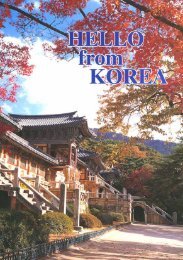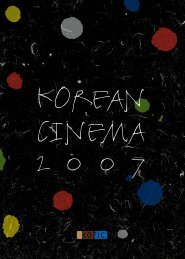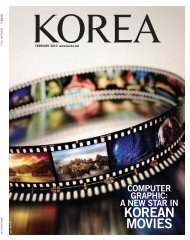2005-2162
12 Innovative Success Stories - Korea.net
12 Innovative Success Stories - Korea.net
- No tags were found...
You also want an ePaper? Increase the reach of your titles
YUMPU automatically turns print PDFs into web optimized ePapers that Google loves.
Jo went on to say that a hanok’s yard<br />
is not something that people just look at<br />
and enjoy visually. It is something that<br />
people use, where people feel the seasons<br />
change.<br />
“Getting a yard is like getting a piece<br />
of nature in a huge room,” Jo says.<br />
One of Jo’s most high-profile projects<br />
was the multiple award-winning La<br />
Gung hotel. La Gung opened in 2007<br />
and enjoyed intense media coverage, as<br />
it was the first high-end, luxury hanok<br />
hotel to open in Korea.<br />
“Often La Gung is fully booked over<br />
the weekend,” said Min Dae-sik at the<br />
Shilla Millennium Park, the film setcum-theme<br />
park that houses the hotel.<br />
“Part of the reason is because it only has<br />
16 villas, but we believe it’s also an indication<br />
that people are responding positively<br />
to hanok structures.”<br />
Jo admits he wasn’t certain La Gung<br />
would succeed when he was first given<br />
the job. After all, it was an unprecedented<br />
project.<br />
“My biggest concern when designing<br />
La Gung was how many traditional<br />
elements I would use and how much I<br />
would adopt modern functions.”<br />
In its completed form, La Gung<br />
embodies the qualities that set Jo apart<br />
from other hanok-savvy architects: It<br />
retains its traditional form and atmosphere<br />
with modern functions and facilities.<br />
Each villa at the hotel has two to<br />
three rooms, a private yard, as well as a<br />
private, open-air hot bath.<br />
After La Gung, Jo worked on another<br />
hanok hotel, a hanok library and a<br />
hanok art gallery. But the architect says<br />
he is most inspired by residential hanok,<br />
and names a hanok in Gahoe-dong<br />
called Seoneumjae as one of his most<br />
memorable projects.<br />
Built in 1934, the hanok was on the<br />
verge of being demolished, with the<br />
owner, like so many who came before,<br />
tempted by a large offer from a real<br />
estate developer. But Jo heard about<br />
Seoneumjae and its historical value and<br />
convinced the owner to opt for renovation<br />
instead.<br />
“I thought about what the best renovated<br />
hanok I’ve ever worked on was. It<br />
was, in fact, my house. I have lived in a<br />
La Gung, Korea’s first highend<br />
hanok hotel, was also<br />
the work of Jo. La Gung embodies<br />
the qualities that differentiate<br />
Jo from from other<br />
hanok-savvy architects by<br />
retaining its traditional form<br />
with modern twist.<br />
A model of<br />
one hanok Jo<br />
saved from the<br />
wrecking ball<br />
was chosen<br />
for an exhibit<br />
at the Korean<br />
Embassy to<br />
the U.S.<br />
Korean Artist<br />
hanok since 2003, but I didn’t renovate it too much.<br />
That’s when I realized that when it comes to hanok<br />
renovation, less is more.”<br />
Although Jo focused on keeping the original frame<br />
and ambiance of Seoneumjae, he did add elements to<br />
please the owner and make life there more convenient,<br />
like a listening room in the basement. Still, Jo made<br />
sure the building’s 70-year heritage was kept as intact<br />
as possible.<br />
That is perhaps why, along with a model of the<br />
130-year-old hanok residence of Korea’s former president<br />
Yun Po-sun in Insa-dong, central Seoul, a miniature<br />
of Seoneumjae was chosen to be displayed at an<br />
exhibition in Washington, D.C., hosted by the Korean<br />
Embassy.<br />
A graduate in architecture of the prestigious Seoul<br />
National University, Jo opened his first office, Guga<br />
Architects, in 2000. That was also when he initiated<br />
what he calls the “Wednesday survey.” Every Wednesday<br />
he heads out to examine and document buildings,<br />
alleys and other urban structures and elements in and<br />
around the Seodaemun-gu area.<br />
So far he has done more than 460 such surveys and<br />
completed nine detailed scrapbooks. Looking over<br />
them today, one is struck by Jo’s persistence, even stubbornness.<br />
But along the way, Jo said, he has learned<br />
more about life than about architecture.<br />
The 43-year-old says that through the surveys he<br />
has come to a better understanding of the way people<br />
live, and of Seoul as a historic yet constantly changing<br />
city.<br />
“Different people live differently, according to their<br />
walks of life, financial circumstances and whatnot.<br />
Some of the places may look dark, cramped and old,<br />
but still they are a precious backdrop to someone’s life,<br />
just like any other place. A good city is one where different<br />
people can live in harmony.”<br />
<br />
By Kim Hyung-eun<br />
December 2009 korea 51<br />
[JonngAng Ilbo]

















